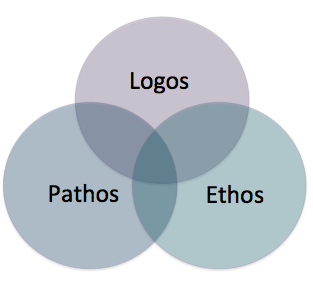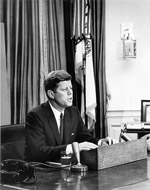Learn It
Being able to evaluate an author’s use of reasoning and evidence is one of the most important skills of an informed citizen. An author’s claim can be presented in a variety of formats, including a speech, video, campaign advertisement, blog post, newspaper editorial or article.
When presenting a claim, an author will use different types of evidence to persuade you to believe that the claim is valid or correct. There are three techniques used by authors to convince the reader to support their position or point of view: pathos, ethos and logos. When evaluating the validity of an author’s claims, you are looking for relevance and quality of the evidence, and acknowledgement of opposing claims with evidence and reasoning that refute those claims.

Logos, pathos and ethos are three techniques authors use to support a claim.
First read and listen to the excerpt from President John F. Kennedy's "Report to the American People on Civil Rights." (A video of the speech is available at JFK Presidential Library and Museumopens in new window .) Then, examine parts of the text to identify the rhetorical techniques used, and the degree of reasoning and evidence provided to convince the audience of the author's claim.
"Good evening, my fellow citizens:
This afternoon, following a series of threats and defiant statements, the presence of Alabama National Guardsmen was required on the University of Alabama to carry out the final and unequivocal order of the United States District Court of the Northern District of Alabama. That order called for the admission of two clearly qualified young Alabama residents who happened to have been born Negro.
That they were admitted peacefully on the campus is due in good measure to the conduct of the students of the University of Alabama, who met their responsibilities in a constructive way.
I hope that every American, regardless of where he lives, will stop and examine his conscience about this and other related incidents. This Nation was founded by men of many nations and backgrounds. It was founded on the principle that all men are created equal, and that the rights of every man are diminished when the rights of one man are threatened.
Today, we are committed to a worldwide struggle to promote and protect the rights of all who wish to be free. And when Americans are sent to Vietnam or West Berlin, we do not ask for whites only. It ought to be possible, therefore, for American students of any color to attend any public institution they select without having to be backed up by troops.
It ought to be possible for American consumers of any color to receive equal service in places of public accommodation, such as hotels and restaurants and theaters and retail stores, without being forced to resort to demonstrations in the street, and it ought to be possible for American citizens of any color to register and to vote in a free election without interference or fear of reprisal.
It ought to be possible, in short, for every American to enjoy the privileges of being American without regard to his race or his color. In short, every American ought to have the right to be treated as he would wish to be treated, as one would wish his children to be treated. But this is not the case.
The Negro baby born in America today, regardless of the section of the State in which he is born, has about one-half as much chance of completing a high school as a white baby born in the same place on the same day, one-third as much chance of completing college, one-third as much chance of becoming a professional man, twice as much chance of becoming unemployed, about one-seventh as much chance of earning $10,000 a year, a life expectancy which is 7 years shorter, and the prospects of earning only half as much."
President John F. Kennedy, “Report to the American People on Civil Rights, 11 June 1963”
Source: JFK Presidential Library and Museum opens in new windowLet’s examine each technique closely.
Ethos
The first technique is ethos, which is an appeal to the reader that they should agree with the author because of the author's character or credibility. The author may reference an occupation, reputation, past actions or expertise. This type of support is illogical, or a logical fallacy. It is not a valid form of evidence to support a claim.
This technique may also be used to discredit opposing points of view by attacking the character of the opposition. This type of evidence is also considered logical fallacy or invalid.
Let’s review an example of ethos used by President John F. Kennedy in his television address to the American people on June 11, 1963.
Analysis |
Example from Speech |
The setting for this speech, a national television address to the American people, uses ethos because the author (President Kennedy) indirectly references his power as president of the United States as he addresses the American people. Notice the yellow highlights. In this excerpt President Kennedy notes the presence of the National Guardsmen and the U.S. District Court of the Northern District of Alabama, thereby indirectly referencing his power as president to make such orders. |
Ethos
This afternoon, following a series of threats and defiant statements, the presence of Alabama National Guardsmen was required on the University of Alabama to carry out the final and unequivocal order of the United States District Court of the Northern District of Alabama. That order called for the admission of two clearly qualified young Alabama residents who happened to have been born Negro. |









